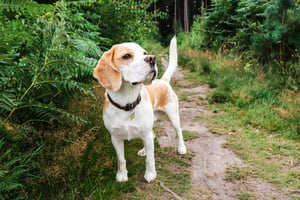Training your dog is a difficult but rewarding task. It's important to learn how to discipline your...
How to Discipline a Puppy for Biting
Training a puppy not to bite can be a challenging task, but it is important to teach it from a young age. This article will provide a step-by-step guide on how to discipline a puppy for biting, as well as offering advice on how to prevent it from re-occurring. It will also cover how to provide a safe environment for your puppy and how to use positive reinforcement to achieve desired behaviour.
Understanding the Reasons Behind the Biting
The first step in disciplining a puppy for biting is to understand why it is doing it. Puppies bite for a variety of reasons, such as play, fear, or excitement. It may be that the pup is teething and needs something to chew on, or that it has not been socialised properly and is feeling threatened by a new person or situation. Understanding the cause of the biting behaviour will help you to better address it.
It is important to remember that puppies bite for a variety of reasons, and that understanding the cause of the behaviour is the first step in successfully disciplining a puppy for biting.
Providing a Safe Environment
Providing a safe and secure environment for your puppy is essential. This should include plenty of space to explore, an area with comfortable bedding, and toys to chew on. Make sure that there is always someone around to supervise the pup, and that it is not left alone for long periods of time. Establish a routine for the pup and ensure that it has regular exercise and play time.
Providing a safe and secure environment for your puppy is essential for successful discipline.
Positive Reinforcement
Positive reinforcement is an effective way to encourage desired behaviour. When disciplining a puppy for biting, it is important to reward it for good behaviour. Give the pup treats or toys when it behaves in the way you want it to and ignore it when it does not. This will help it to understand that biting is not an acceptable behaviour.
Positive reinforcement is an effective way to encourage desired behaviour in puppies.
Redirecting the Biting
When disciplining a puppy for biting, it is important to redirect the behaviour. If the pup is biting people or furniture, give it a toy to bite instead. If it is biting out of fear or excitement, try to distract it with a toy or game. This will help the pup to understand that biting is not an acceptable behaviour.
Redirecting the biting behaviour is an important part of disciplining a puppy for biting.
Consistency is Key
When disciplining a puppy for biting, it is important to be consistent. Every time the pup bites, it is important to be firm and consistent in your response. If you do not respond consistently, the pup will not learn that biting is wrong. It is also important to be patient and give the pup time to learn.
Consistency is key when disciplining a puppy for biting.
Provide an Outlet for Excess Energy
Puppies have a lot of energy, and this can often lead to biting. Providing an outlet for this energy is important. Make sure that the pup has regular exercise, and that it has access to toys and games. Teaching the pup to play fetch or tug of war can help to provide an outlet for excess energy.
Providing an outlet for excess energy is an important part of disciplining a puppy for biting.
Seek Professional Help if Necessary
If the pup's biting behaviour does not improve, it is important to seek professional help. A qualified animal behaviourist can help to diagnose the cause of the behaviour and offer advice on how to address it. It is also important to consider the pup's age, as puppies under six months of age may need to be socialised in order to reduce biting.
If the puppy's biting behaviour does not improve, seeking professional help is important.
Conclusion
Training a puppy not to bite can be a challenging task, but it is important to teach it from a young age. This article has provided a step-by-step guide on how to discipline a puppy for biting, as well as offering advice on how to prevent it from re-occurring. It has also covered how to provide a safe environment for your puppy and how to use positive reinforcement to achieve desired behaviour. Understanding the cause of the biting behaviour and being consistent in your response is key.
Understanding the cause of the biting behaviour and being consistent in your response is key when disciplining a puppy for biting.



